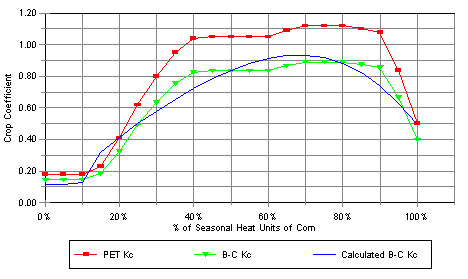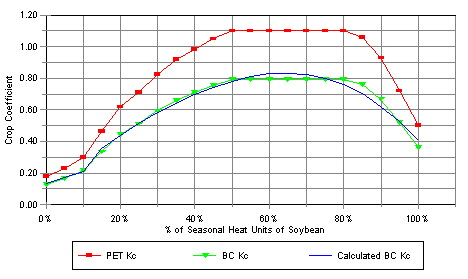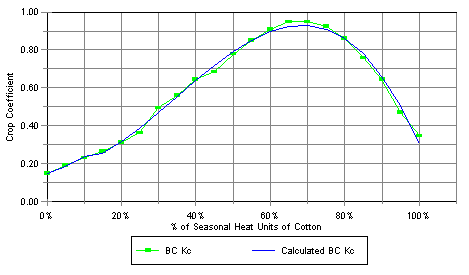
The Blaney-Criddle evapotranspiration equation is used. Daily values of evapotranspiration (ETBC) are calculated using a splining function upon published monthly mean values of daily maximum and minimum temperatures. Latitudinal values are used to calculate daylight hours, part of the Blaney-Criddle equation. A database was established that contains, for each Missouri county, daily maximum temperature, daily minimum temperature, and daily ETBC. These data were based on 30-year weather records.
The result gives a smooth curve of daily reference evapotranspiration values for the entire year (Fig. 1).

The software has an adjusting factor that can lower or raise ET values. This adjustment tool is located on the same screen that displays the crop's seasonal water use value (inches) and peak water use (inches per day [ipd]); this screen appears right before the final Woodruff graph is generated. If either water unit value seems too high or too low, the adjustment factor can be used, which then adjusts all daily values accordingly. As an example, the screen might show that a corn hybrid that emerged April 25 in Mexico, MO is projected to have a seasonal water use of 21.1 inches with a peak water use of 0.28 ipd. If the grower has reason to believe that the peak water use of corn for his area is 0.30 ipd he can toggle up the peak water use to 0.30 and this will raise all daily ETBC values by 1.07 (0.30/0.28). The new seasonal water use then becomes 22.6 inches.
Crop coefficients for corn, soybeans, and cotton are Heat Unit-based and are calculated on a procedure that involves percentage of seasonal Heat Units. The fourth order polynomial that describes daily crop coefficient values is:

where,
%HUj = % of accumulated Seasonal Heat Units as of day, j
Kcj = crop coefficient on any day, j
and A,B,C,D and E are coefficients.
Calculations for Heat Unit-driven Kc values for corn and soybean are the similar to ones used in the University of Missouri's weather station network as seen on AgEBB, (University of Missouri Outreach and Extension's electronic bulletin board) except that they have been adjusted to reflect the fact that AgEBB uses potential evapotranspiration as their reference ET value. The adjustment values were very close to the value (0.80) used by Gregory and Schottman when they had investigated the problem in the 1980's. The cotton Kc values were derived by extracting values of daily water use of soybean and cotton under conditions of same emergence and termination rate and same weather conditions in 10-day increments from the Arkansas Scheduler computer program. The ratios of water use between the two crops were used to adjust the soybean Kc so that it reflected the Kc value of what cotton would be. The parameters used on the Kc equations for the various crops is shown in Table 1.
| crop | intercept | % HU | % HU^0.5 | %HU^2 | %HU^3 |
|---|---|---|---|---|---|
| Corn | 0.1134 | -0.0985 | 0.7476 | 2.6551 | -2.8851 |
| Soybean | 0.1347 | 0.6402 | 0.4641 | 1.0837 | -1.8921 |
| Cotton | 0.1502 | 0.4561 | -0.2223 | 4.5172 | -4.6066 |
The farmer provides emergence date in the program, but since crop coefficients are reported as a function of % of seasonal Heat Units, it is important to know when the crop terminates so that total Heat Units can be calculated. The last date of water use in the season is based on these estimates are:
HU black layer = A + B * RM
where,
HU black layer = total Heat Units (50/86) from emergence to black layer formation
RM = relative maturity of hybrid
Once the emergence date and black layer date are known, the seasonal Heat Units (base 50 with 86 degrees as upper limit on maximum) can be calculated. Daily crop coefficient values are based on % of seasonal Heat Units experienced up to that date.
Soybeans. The maturity date is derived by adding an estimate of days (L) until maturity to the emergence date. L is a function of emergence date, latitude, and Maturity Group of the soybean used. The equation to calculate L was obtained by correlation analysis of data on various university soybean variety trials at latitudes ranging from 34 to 46 degrees north. The equation is:
L = -0.712(DOY) + 0.0015116(DOY^2) + 0.9241(LAT) + 9.09(MG)
where:
L is period from emergence to maturity, days
DOY is Julian date of emergence
LAT is latitude of field to be irrigated
MG is soybean maturity group (2-6)
Once the emergence date and maturity date are known, the seasonal Heat Units (base 60 with no upper limit on maximum) can be calculated. Daily crop coefficient values are based on % of seasonal Heat Units experienced up to that date.
Cotton. Cotton is by nature a perennial, so cessation of its water use is dependent on either the occurrence of sufficiently cold enough weather or the application of crop desiccants. For Missouri conditions, the occurrence of 55-degree weather in the fall is close in time to normal applications of crop termination chemicals. Once the emergence date and the date of 55-degree fall weather (determined by interrogating the county data file) are known, the seasonal Heat Units (base 60 with no upper limit on maximum) can be calculated. Daily crop coefficient values are based on % of seasonal Heat Units experienced up to that date.
The figures below show Kc values used in the program.



[ Contact Joe Henggeler for Questions/Comments ]
[ Woodruff Instructions and Background Information ] [ AgEBB ]